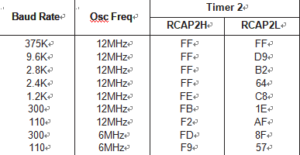Philip MCU P89C60 Memory Data Duplication
Philip MCU P89C60 Memory Data Duplication refers to dump the code from both eeprom and flash and then programming them into other blank MCU which will perform the same functions as original P89C60.
When Timer 2 is in the baud rate generator mode, one should not try to read or write TH2 and TL2. As a baud rate generator, Timer 2 is incremented every state time (osc/2) or asynchronously from pin T2; under these conditions, a read or write of TH2 or TL2 may not be accurate. The RCAP2 registers may be read, but should not be written to, because a write might overlap a reload and cause write and/or reload errors. The timer should be turned off (clear TR2) before accessing the Timer 2 or RCAP2 registers.
Table 5 shows commonly used baud rates and how they can be obtained from Timer 2.
Timer 2 is in baud rate generating mode. If Timer 2 is being clocked through pin T2(P1.0) the baud rate is:
Baud Rate = Timer 2 Overflow Rate
16
Bits TCLK and/or RCLK in T2CON (Table 5) allow the serial port transmit and receive baud rates to be derived from either Timer 1 or Timer 2. When TCLK= 0 from Philip MCU P89C60 Memory Data Duplication, Timer 1 is used as the serial port transmit baud rate generator. When TCLK= 1, Timer 2 is used as the serial port transmit baud rate generator. RCLK has the same effect for the serial port receive baud rate. With these two bits, the serial port can have different receive and transmit baud rates – one generated by Timer 1, the other by Timer 2.
Figure 6 shows the Timer 2 in baud rate generation mode. The baud rate generation mode is like the auto-reload mode,in that a rollover in TH2 causes the Timer 2 registers to be reloaded with the 16-bit value in registers RCAP2H and RCAP2L, which are preset by software.
The baud rates in modes 1 and 3 are determined by Timer 2’s overflow rate given below:
Modes 1 and 3 Baud Rates = Timer 2 Overflow Rate
16
The timer can be configured for either “timer” or “counter” operation. In many applications, it is configured for “timer” operation (C/T2*=0). Timer operation is different for Timer 2 when it is being used as a baud rate generator.


